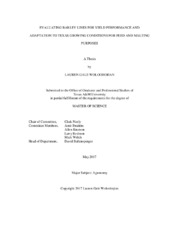| dc.description.abstract | Around the 1960s, barley was grown on nearly 170,372 hectares (ha) throughout Texas. Today, it is planted on less than 12,000 ha and is mainly used as a feed and forage source for livestock. In recent years, interest in craft breweries, local malt ingredients and feed barley for a growing dairy industry in the Texas High Plains has increased the popularity of barley. Testing is required to find barley lines adapted to Texas climates that can withstand drought, disease and pest pressure.
The purpose of this study was to evaluate and identify adapted barley lines for feed and malting purposes under multiple environments across different growing regions of Texas. The specific objectives of this study were to 1) Evaluate and identify superior TCAP (Triticae Coordinated Agricultural Project) barley lines for yield and malt quality in Texas environments, 2) Determine desirable phenotypic characteristics for barley grown in Texas and 3) Evaluate the economic feasibility of barley production in Texas. Winter, facultative, spring two- and spring six-row barley was evaluated over Harvest Years 2014, 2015 and 2016.
In-field and lab evaluations were taken over the growing and harvest seasons. Statistical analysis using PROC CORR in SAS and bi-plot analysis of data was conducted to determine relationships among measured field, yield and grain quality parameters across environments. Each barley type performed differently at each location throughout Texas, however, similarities in performance were found at locations across harvest years. Insect pressure was not major limiting factors to TCAP barley performance at all locations used. However, bird damage and rust (Harvest Year 2014 only) was evident and did affect yield of spring six-row barley in McGregor, TX.
By testing various TCAP barley breeding lines and comparing them to commercially available varieties, the project will contribute new information on barley germplasm from breeding programs within the US and identify lines adapted to varying Texas environments. Compared to other small grains, barley is more drought and salt tolerant and may be a desirable option for high-salinity soils and drought-prone regions of the state. Barley is a useful crop, with current and developing markets in Texas for feed and malting. By identifying adapted lines that can be released as commercial varieties in Texas, this research may increase yield potential and profitability of barley versus other crops. Increasing barley acres could potentially improve food security by increasing food production under stressful environments. Cropping systems would also diversify and could provide locally sourced, more sustainable food ingredients for consumers. | en |


